

Perimeter security encompasses a number of different technologies. Some installations use active infrared, photoelectric or other types of beam detectors, sometimes in combination with passive infrared (PIR) motion detectors.

In this article,SDMprofiles perimeter security installations by six security dealers and systems integrators who have solved the unique challenges posed by each location.

Terrorist Threat Inspires Security Upgrades
After a terrorist threat on a propane gas facility in California was discovered before its implementation, a sophisticated microwave detection system was installed along with a fence detection system as part of a complete security upgrade.“We are the largest above-ground refrigerated propane storage facility west of the Mississippi,†asserts Pat Hicks, facilities manager at Suburban Propane, Elk Grove, Calif., which is approximately 16 miles south of Sacramento, California’s capital. “This facility stores approximately 24 million gallons of propane, and all we are is a storage facility. The product comes in in the summer and goes out in the winter.â€
In an incident that received national coverage, two U.S. citizens were arrested in late 1999 and convicted in 2002 of attempting to cause an explosion at Suburban Propane’s facility with a fertilizer bomb to fan Y2K mass hysteria and overthrow the U.S. government. The FBI alerted Suburban Propane to the plot before it was executed.

When the facility originally opened, the area around it was pasture, but now Elk Grove is the fastest growing city in the United States, Hicks maintains.
“Development is on our fence line, and we need to be on the cutting edge of security and fire protection,†he insists. The goal is to achieve the security standards of a federal prison.
Physical barriers include a chain-link fence, on which an electronic fence protection system is installed, and a cable barrier designed to stop vehicles.
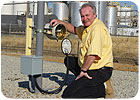
Geno Bartley, owner and field technician for GB Technical, Newport, Ore., adjusts an MPS4100 bi-static microwave at Suburban Propane in Elk Grove, Calif.
He and Bob Williams from the engineering department of the system’s manufacturer, Magal-Senstar Inc. (formerly Perimeter Products), Fremont, Calif., determined that a cathodic protection system to inhibit deterioration and rusting of the pipes and tanks that was unrelated to the security system was causing the problem.
Cathodic systems reduce rust by sending 40 volts of direct current electricity into the ground. That, plus improper installation of the security system’s interconnecting cable, was causing noise in the fence detection system that led to communication problems.
“In outdoor electronic security systems, their ground often is shared with the low-voltage power supply,†Bartley explains. “You never want to have two different voltage sources bucking each other because it causes strange electronic things to happen. When this was originally installed, nobody even considered this.â€
The solution was to isolate the electronic circuit boards of the fence system from the noise with nylon washers and screws and install a new interconnect cable.
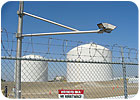
Two Protech Doppler microwaves at the sally port detect trucks or intruders from two different directions to protect the twin tanks at Suburban Propane.
“The transponder cards work on the same data loop, so it was a matter of splitting the system in half and then going around the perimeter and attaching new microwaves to the existing interconnect cable,†Bartley explains.
Instead of mounting the microwave system on steel posts, which usually is done, because of the cathodic protection system, they were electrically isolated on PVC posts. Because vibration could set off the alarm, the posts were stiffened by installing rebar and pouring cement into the middle of them.
Microwave detectors used for this application are point-to-point or bi-static, Bartley notes. Their signals hit flat ground and hover across it until they reach the receiver. A person crawling through the system would cause a disturbance that the system would detect and initiate an alarm.
Because of this, the railroad entrance at one end of the facility posed a challenge. “The railroad tracks stick up kind of tall and that blocks your multipath, so if microwave travels across ground and has something in the way that blocks it, a low-profile person might be able to beat it,†Bartley relates. “Microwaves need a relatively level area between transmitter and receiver.â€
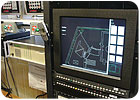
The Psycon Touchscreen graphic display from Magal-Senstar Inc., Fremont, Calif., is used with the MX5040 on the left at Suburban Propane.
“The whole name of the game in outdoor security is you want to keep nuisance alarms to a minimum, or people have no trust in the system,†Bartley points out. “When you use dual technologies, you have two different things that have to happen. You have to have a physical disturbance on the fence, in the microwave zone or body heat to go into alarm for the stereo Doppler microwaves.
“That’s the thing with outdoor security,†he concedes. “There are so many tricks with this business, it takes many years to figure this out. I’ve specialized in this since the early 1980s. When I first got in, hardly anybody was in it. Most security companies know very little about outdoor security. I’m often called in to put out fires.
“There are so many things with environmental conditions,†Bartley declares. “With outdoor security, everything has to be weathertight, you have to use certain types of wire, you’re dealing with wind, rain, storms – there are a lot of factors to consider. A lot of companies get in trouble and take these jobs on and don’t know what they’re doing. I see it all the time.â€
Sidebar: On the Job
- MX5040 – Head in multiplexer from Magal-Senstar Inc.
- PsyconTouchscreen graphic display, Magal-Senstar Inc.
- FPS2-2M – advanced Edapt processing, Magal-Senstar Inc.
- MPS4100 – bi-static microwaves, Magal-Senstar Inc.: www.magalsenstarinc.com
- Doppler microwaves – both passive infrared and stereo microwave, Protech
- Outdoor perimeter alert system: www.protechusa.com
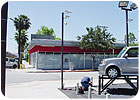
A technician of SummitWatch Inc., Los Angeles, completes a unique wiring system for Crestview Cadillac, West Covina, Calif., under a perimeter beam, a speaker and a video camera on the pole.
Tripped Beams Turn on Live Audio/Video System at Central Station
An automobile lot with buildings and three other auto facilities are being protected with a dual-technology volumetric beam system that is integrated with audio/video and is monitored 24 hours a day, seven days a week by a central station.“If somebody trips the perimeter beams, we get an annunciation called priority 7,†explains Hugh Tidwell, vice president of operations for SummitWatch Inc., Los Angeles. “We will get four pictures – three still and one live – of the intruder, and we are immediately talking to them.â€
How the intrusion is handled depends on the time of day, Tidwell reveals. The lot at Crestview Cadillac, West Covina, Calif., is monitored from 6 p.m. to 10 a.m. daily. “At 7 a.m., it might be a guy looking for a car on the way to work,†Tidwell concedes.
An announcement is made by the operator, such as, “Good morning. Feel free to look. Your actions are being recorded onsite,†Tidwell recites. “At 2 a.m., they are not looking at cars. We say, ‘This is security. Leave the lot immediately,’ and we call the police.â€
The dealerships’ buildings also are monitored with indoor cameras, Tidwell notes. “A lot of our clients have eliminated their burglary and fire alarms because we’re watching the facility,†he reports. “We never recommend that, but some of them choose to make the savings.â€
The motion detectors at the perimeter of the parking lots use infrared and microwave technology, Tidwell explains. “There is no way to go over it or under it,†he maintains. “These are volumetric – they have no pattern. They flood the area.
“They don’t create an X or grid or anything you can penetrate,†he insists. “It is a solid curtain from ground level to 13 feet high. You can set it for the sensitivity to take out birds or cats. We put the beams on the existing light poles on the car lots and cable to the poles.â€
The company uses a unique cable installation method. “A lot of companies tear up the asphalt and trench,†Tidwell asserts. “One really unique thing we do is a four-inch grind cut in the asphalt with a diamond-blade slab saw, similar to ones you see on the freeway.
“We lay cable in that and recaulk it so the disruption to the business is minimal,†he notes. “We might have to move a few cars, and then we caulk it and power wash, and you never know we were there.â€
Sometimes if the light poles are not positioned properly for the perimeter beams, SummitWatch installs its own 20-foot posts to hold the beams.
When an intrusion is detected by the beams, day/night pan-tilt-zoom dome cameras zoom in on the intruder and DVRs record the event. The system was installed at the beginning of this year at several facilities that are all under the same ownership, including Crestview Cadillac, another Cadillac dealership, a used car lot, and a remote storage lot.
Sidebar: On the Job
- Model 457 and 467 perimeter beams, ASIM, Billerica, Mass.: www.asim-technologies.com
- Spectra III day/night PTZ video cameras, Pelco, Clovis, Calif.: www.pelco.com
- AdPro DVR, Vision Systems, Norwell, Mass.: www.vsl.com
- Public address amplifiers, Bogen Communications Inc., Ramsey, N.J.: www.bogen.com

Video analytics software with fixed and PTZ surveillance cameras provide perimeter protection at the Port of Wilmington, Del.
Video Analytics System Is Employed for a Port’s Perimeter Security
Video analytics software is used in conjunction with an extensive network of fixed and pan-tilt-zoom surveillance cameras to provide perimeter protection at the Port of Wilmington, Del. The port, one of the busiest on the East Coast, handles more than 400 vessels annually and up to 5 million tons of cargo.“The port is roughly 300 acres,†describes Eric Schaeffer, owner and president of Advantech Inc., Dover, Del., the project’s integrator. “On its eastern side is the Delaware River and on its northern edge is the Christina River, which meets the Delaware at the northeast point of the port.â€
The port has docking facilities for large vessels. “The maximum I’ve seen is three large freight-type ships along the main docking facility,†Schaeffer notes. “Then there’s usually one vehicle-containing ship on the autoberth. These are very large ships holding several thousand vehicles.â€
The main entrance is on Terminal Avenue just off I-95. “That’s the main entry and exit point for all cargo haulers,†Schaeffer explains. The port also is served by a railroad spur with controlled access.
“Then there are two other vehicle entrances that are typically used for certain types of cargo like heavy materials and also large quantities of vehicles being moved through to the storage lots,†he continues. “All entrances including the railroad entrance are controlled through security management and gate operators.â€
On the design end, the manufacturer and video analytics software company were highly involved and on-site. Schaeffer also credits Jim Seningen, a fiber-optic engineer, and Mick Soyka, an electrical engineer, with PEI electrical contractors.
“Every site is unique and has different situations that need to be addressed, so it’s not like it’s a cookie-cutter approach,†Schaeffer declares. “There is a lot of work on site as far as calibrating the cameras and getting the right field-of-view and setting up the processors.â€

Alarms from fixed-position cameras notify the associated PTZ to track the target. This allows operators to manually call up cameras and control PTZs.
The managers of the Port of Wilmington, the Diamond State Port Corp., requested statements of qualifications to secure the entire perimeter of the port using grant money provided by the Office for Domestic Preparedness (ODP).
Advantech went through an extensive proposal process to obtain the project at the port, where they had secured the main entrance shortly after 9-11. The short list of integrator candidates was evaluated through an interview and presentation process. Advantech and its team scored the most points, thereby winning the project.
The company also had to submit conceptual designs that were fleshed out as soon as they won the project. “It was the entire team,†Schaeffer notes. “It wasn’t us sitting down and designing a solution. It was a true design/build. We had the objectives of what they wanted accomplished, which was a lot, with that round of grant money. We put more into it than we originally thought the budget could support.
“What took a fair amount of time was setting up the perimeter fields-of-view for the video analytics,†Schaeffer reports. “You cover your entire perimeter with fixed-position cameras, and then for interrogation purposes, PTZ cameras are spaced incrementally around the property.â€
An alarm from the video analytics software that uses a fixed-position camera will notify the appropriate PTZ camera to track the target, Schaeffer notes. A single interface is used to track activities throughout the facility.
“So if you get an alarm from a fixed-position camera, it will position the associated PTZ to track the target,†he explains. “Activities and alarm conditions are displayed on the wide-area surveillance screen which also allows operators to manually call up cameras and control PTZs.
“Ideally, the operator’s primary function is to acknowledge and react to alarm events,†Schaeffer points out. “So if it’s a land-based event or a water-based event, it’s going to highlight the target and display the associated fixed-camera view and use interrogation PTZ to track that target.â€
A fiber-optic network was installed throughout the port for communication with the field components. Primary and emergency power needed to be distributed to power these components. “That took a lot of the design end,†Schaeffer notes.
“A lot of these ports are on old reclaimed pieces of land,†he points out. “Our team had to be careful. We had to trench a fair amount and used underground radar to make sure we weren’t going to hit something we didn’t want to hit.â€
Sidebar: On the Job
- Pro-Watch Corporate Edition (CE), Honeywell Security, Syosset, N.Y.
- Honeywell Fusion and Rapid Eye DVR management software
- Honeywell Fusion DVRs with 4 TB of additional storage
- Honeywell Rapid Eye DVRs for video verification
- Honeywell HD6 ruggedized day/night PTZs: www.honeywell.com
- VistaScape video analytics software and hardware
- MagnaView camera systems
- Dinion Series high-performance, low-light cameras, Bosch Security Systems: www.boschsecurity.us
- Fiber-optic video/data and Ethernet transceivers, IFS, Newtown, Conn.: www.ifs.com
- Servers, processors, switches and KVM, HP, Palo Alto, Calif.: www.hp.com
- Barrier arm operators, DKS DoorKing Inc., Inglewood, Calif.: www.doorking.com
- Hydraulic barrier arm operators, HySecurity, Kent, Wash.: www.hy-security.com
- Speed Space 6-foot by 8-foot security control booths
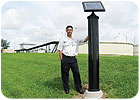
Bob Houston, CEO of Solarbeam Security LLC, Homestead, Fla., developed the wireless solar-powered towers with infrared photoelectric beams that protect a wastewater treatment plant in Homestead without requiring piping, trenching or extensive labor for installation of power or communication lines.
Photo Beams Powered by Solar Towers Make for a Smooth Installation at Wastewater Plant
Wireless solar-powered towers with infrared photoelectric beams secure a wastewater treatment plant in Florida without requiring piping, trenching or extensive labor for installation of power or communication lines. They also are less prone to damage from lightning strikes.The plant in Homestead, Fla., is one of several city facilities using the wireless towers. The high-low dual infrared photoelectric beams operate off of batteries inside the tower that are recharged by the solar panels.
When the beams are broken, the towers transmit a radio frequency (RF) signal into a control board that has each area or beam zone identified, explains Matthew Forristall, owner of Aressco Services Inc., Miami, an authorized dealer of the towers and a licensed alarm contractor. The wireless signal can be transmitted up to five miles, and use of a repeater can extend the transmission distance.
“There are two relay outputs, and one goes into the master control and voice annunciation panel and one into their computer monitoring network system for the plant,†Forristall relates. “The control panel monitors the zones and alerts the security guard to view the area via video camera from a remote site.â€
The video cameras record the alarm and a DVR archives it. The incident is recovered by date and time in an event log that records the beam alarms.
Forristall estimates the facility’s size at approximately 10 acres, which is covered by 10 towers. “The towers jog back and forth,†he says. “The distance varies. At this facility, we have to turn corners – it’s not perfectly square. Some beams go 30 to 40 feet and then some up to 700 feet.â€
Each job has its towers custom-designed, depending on the distances they have to project their beams and whether they are corner units or going straight along a perimeter. “When the job is laid out, each tower is designed to go into that typical location,†Forristall notes.
The beam towers are mounted on 250-pound concrete cement pedestals. “The installation went really smoothly,†Forristall maintains. “We just dug a hole, put the cement pedestal in the hole and attached the beam to it.â€
The towers withstood Hurricanes Katrina and Wilma recently, he reports, although the storms were only Category 1 or 2 when they passed over Florida.
The beams and video system are always on, even during power outages, but the voice annunciation system can be turned off or bypassed when maintenance is being done around a particular zone’s beams. Installation of the security system at the wastewater treatment plant was completed in November 2005.
Bob Houston, CEO, Solarbeam Security LLC, developed the wireless solar towers over the years he and Forristall were in a security company together. Their customers’ wired perimeter security systems around nurseries and auto lots were plagued by lightning strikes from Florida’s frequent afternoon thunderstorms.
“So over time, Bob developed the solar-powered beam to limit lightning damage and make installation easier, so you didn’t need a month to dig up the property,†Forristall recalls. “Each tower is isolated, so if it does get hit, it’s just one device, not five units.â€
The beam towers were developed painstakingly over years of trial and error in real applications, some of them with the city of Homestead, where Solarbeam also is located, Forristall remembers. Solarbeam Security LLC, is now a sole-source vendor for the city. The solar towers are used throughout the United States and even in Oregon, where direct sunlight is less frequent, Houston notes.
“Over the years, we’ve done installations around Homestead facilities with earlier generations of beams,†Forristall notes. “The city was already familiar with the product, and since we’re right there in Homestead, it was fairly easy for them to come to us, because they knew we had a product and they had the need.â€
Sidebar: On the Job
- Solar wireless towers manufactured by Solarbeam Security LLC, Homestead, Fla.
- Master control panel, Solarbeam Security LLC
- Multi-zone wireless receiver transmitter, Solarbeam Security LLC: www.solarbeam.com
- High-low dual infrared photoelectric beams, Optex America, Chino, Calif.: www.optexamerica.com
- Vista control panel, Honeywell Security, Syosset, N.Y.: www.honeywell.com
- Video surveillance cameras, Panasonic Security Systems, Secaucus, N.J., and Samsung Optical America Inc., Secaucus, N.J.: www.panasonic.com/security
www.samsung.com - DVRs, Dedicated Micros, Chantilly, Va.: www.dedicatedmicrosus.com
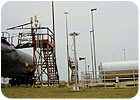
Dual PIR sensors and Doppler microwave detection are used by Ener-Tel Services Inc., San Angelo, Texas, to secure water treatment plants.
Dual Motion Sensors Activate the Video System at Water Plant
Ener-Tel Services Inc., San Angelo, Texas, secured its client’s water treatment plants using dual PIR sensors and Doppler microwave detection, with pan-tilt-zoom video cameras and DVRs.Operators in the plants’ control rooms are on guard 24 hours a day, 7 days a week to examine any video footage that is captured by the triggering of the dual-technology sensors. The two technologies help eliminate many false alarms, points out Jon Allen Richardson, regional sales manager for Ener-Tel Services.
“Without the dual detection, you would end up getting a lot of false alarms,†Richardson concedes. “With dual detection, once it sees both the PIR and Doppler, it automatically goes into alarm, and that reduces the amount of false alarms tremendously.â€
The motion detectors were installed by Ener-Tel Services as part of the perimeter security systems at some water treatment facilities in Texas, which are unidentified for security reasons. Mark Perez, manager of technical support and sales for Protech, helped substantially with the application of their sensors to specific sites, Richardson notes.
“On the water treatment plants, some of the problems you’re running into are that they are fairly large areas, and then buildings are scattered throughout that are in the way,†Richardson explains. “There are quite a few blind spots.â€
In some areas, up to six dual-technology motion detectors are used and their outputs connected to the inputs on the pan-tilt-zoom cameras. On a square building that has two cameras on opposite corners, the motion detectors can direct the cameras to follow the person all around the building, Richardson notes. The cameras are connected to DVRs that keep a record of any intrusions.
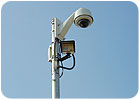
PTZ video cameras and DVRs work on conjunction with the PIR sensors and Doppler microwaves. Operators in the plants’ control rooms are on guard 24/7 to examine any video that is set off by the dual-technology sensors. The two technologies help eliminate many false alarms
Special coatings were applied to the electronic circuit boards in the sensors by the manufacturer, at Ener-Tel’s request, to protect them from some of the corrosive environments in water treatment plants, such as high concentrations of chlorine, Richardson notes.
Cabling that works by magnetic induction also was used on the fence surrounding such facilities. “It looks like a piece of coaxial cable,†Richardson explains. “It can tell if something is near, if someone is cutting the fence or climbing on it or clipping the wires.â€
The wire also can be placed around a gate and sense if it is being tampered with, he points out. The pan-tilt-zoom cameras can be alerted to any intrusion attempts.
Wireless transmission at 2.4 GHz is used in some facilities along with a wireless Ethernet backbone. Recently, the company has begun installing fiber-optic cable.
“With wireless, you’ve always got the element of something going down, but with fiber optics, unless your lines are cut, you can depend on it,†Richardson asserts.
“You can almost eliminate lightning surges completely,†he notes, because fiber optic cable is glass. It also does not require an antenna as wireless does, which also can be a target of lightning.
“If you end up with buried copper, even if there isn’t lightning in the area, you always have the potential of a ground difference between the buildings,†he points out. “If one building is grounded better than the other, it can pull current through your buildings. So we try fiber between buildings so you have no path for the current to travel at all.â€
“We’ve done a little bit of everything,†Richardson declares about his company’s outdoor security projects. “The meat and potatoes is the exterior motion sensors. Those are really what make it happen for you.â€
Sidebar: On the Job
- Piramid XL2, Protech, Reno, Nev.: www.protechusa.com
- Spectra III day/night PTZ video cameras, Pelco, Clovis, Calif.: www.pelco.com
- Intelleflex cabling, Senstar-Stellar, Carp, Ontario, Canada: www.senstarstellar.com
- DVXI DVR, Integral Technologies Inc., Indianapolis: www.integraltech.com
- 2.4 GHz wireless transmitters and receivers
- Wireless Ethernet backbone from Wi-LAN, Calgary, Alberta, Canada: www.wi-lan.com
- Fiber-optic transmitter, Internet Security Systems (ISS), Atlanta: www.iss.net
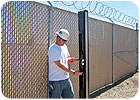
Three quad active infrared beam sets within each tower are wired in series by Geo-Tech Security Inc., Pittsburg, Calif., to secure a power plant.
Quad Beam Sets Are Custom Installed to Boost Reliability at Power Plant
A power plant is being protected with a system installed by Geo-Tech Security Inc., Pittsburg, Calif., which combines active infrared beams with video surveillance equipment.The perimeter of the plant is protected with three quad beam sets within each tower wired in series. “An alarm occurs if any one set is tripped,†relates George Iaconis, Geo-Tech Security’s owner. “All four beams have to be broken within one set in order to cause an alarm.â€
With this type of system, a bird flying low or a fox running through the beams would not cause an alarm. The towers are 6.5 feet high and the beams cross horizontally and diagonally to create a rectangle and an X pattern between them. “We have a very low frequency of false alarms,†Iaconis maintains. “The beams are extremely reliable.â€
To improve their efficiency in fog, the active infrared beams are spaced 300 feet apart instead of the maximum 600 feet. This reduces the number of foggy days on which the beams do not operate by 90 percent, Iaconis calculates.
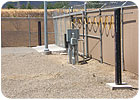
With this type of system, a low-flying bird or small mammal crossing through the beams would not cause a system alarm.
“So the system can be totally controlled from a remote site including cameras,†he relates. “We set the system up so it can be on 24 hours a day. When the front gate opens, it automatically shunts the beam that goes across the driveway.â€
The ADI Systems Group, Orange, Calif., designed the system for Geo-Tech, Iaconis tells. “When I took the project to them, they designed it and said this is what they recommended,†he remembers. “They were a pretty big help in putting the project together parts-wise.â€
Installation of the plant’s perimeter security system was completed in 2003. Its exact location in California cannot be disclosed for security reasons.
“We have a maintenance contract where we go to the site every three months to make sure the beams are aligned properly, and the siren still goes off, and do any general maintenance that needs to be done to the system,†Iaconis says. “We have several plants throughout the state that we take care of for them.â€
Sidebar: On the Job
- PBIN 200HF photoelectric beams, Takex America Inc., Sunnyvale, Calif.: www.takex.com
- AL600 Series power supplies, Altronix: www.altronix.com
- BT 200 6.5-foot tall towers, Takex America: www.www.takex.com
- Rapid Eye PTZ dome video cameras, Honeywell, Syosset, N.Y.
- Rapid Eye DVR, Honeywell
- Northern Computers control panel running WINPAK 2.0 software: www.honeywell.com
Links
- ASIM
- ASIM
- ASIM
- ASIM
- Internet Security Systems (ISS)
- Internet Security Systems (ISS)
- Internet Security Systems (ISS)
- Internet Security Systems (ISS)
- Pelco
- Pelco
- Pelco
- Pelco
- Bogen Communications Inc.
- Bogen Communications Inc.
- Bogen Communications Inc.
- Bogen Communications Inc.
- Protech
- Protech
- Protech
- Protech
- Honeywell Security
- Honeywell Security
- Honeywell Security
- Honeywell Security
- Vision Systems
- Vision Systems
- Vision Systems
- Vision Systems
- Altronix
- Altronix
- Altronix
- Altronix
- Panasonic Security Systems
- Panasonic Security Systems
- Panasonic Security Systems
- Panasonic Security Systems
- Dedicated Micros
- Dedicated Micros
- Dedicated Micros
- Dedicated Micros
- Samsung Optical America Inc.
- Samsung Optical America Inc.
- Samsung Optical America Inc.
- Samsung Optical America Inc.
- HySecurity
- HySecurity
- HySecurity
- HySecurity
- Bosch Security Systems
- Bosch Security Systems
- Bosch Security Systems
- Bosch Security Systems
- Takex America Inc.
- Takex America Inc.
- Takex America Inc.
- Takex America Inc.
- Solarbeam Security LLC
- Solarbeam Security LLC
- Solarbeam Security LLC
- Solarbeam Security LLC
- Magal-Senstar Inc.
- Magal-Senstar Inc.
- Magal-Senstar Inc.
- Magal-Senstar Inc.
- Wi-LAN
- Wi-LAN
- Wi-LAN
- Wi-LAN
- HP
- HP
- HP
- HP
- Senstar-Stellar
- Senstar-Stellar
- Senstar-Stellar
- Senstar-Stellar
- Integral Technologies
- Integral Technologies
- Integral Technologies
- Integral Technologies
- DKS DoorKing Inc.
- DKS DoorKing Inc.
- DKS DoorKing Inc.
- DKS DoorKing Inc.
- IFS
- IFS
- IFS
- IFS
- www.protechusa.com
- www.protechusa.com
- www.protechusa.com
- www.protechusa.com
- Optex America
- Optex America
- Optex America
- Optex America